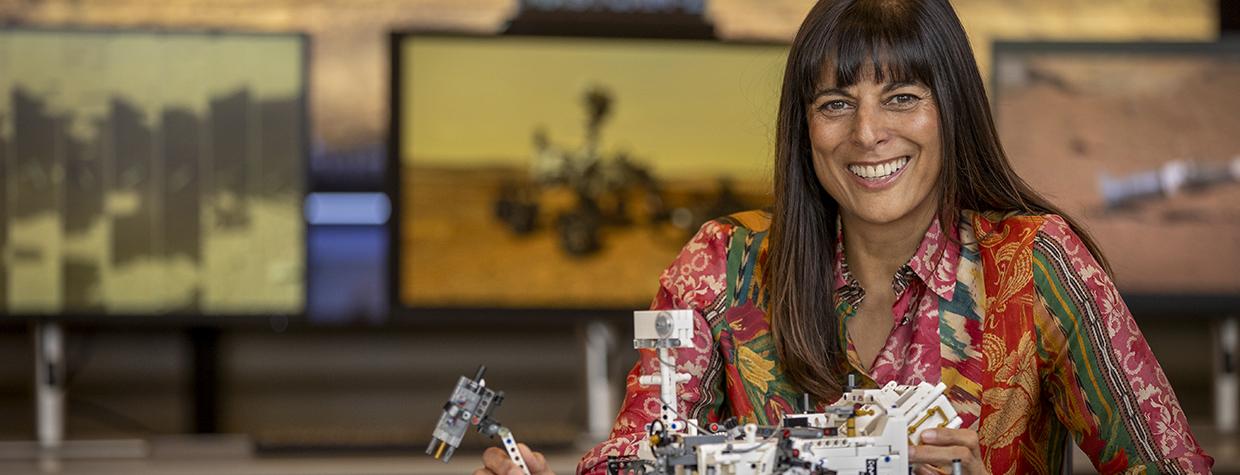Sometimes, to see the big picture, you have to look at the granular details. So, instead of studying the solar system through a telescope, planetary scientist Meenakshi Wadhwa examines meteorites though a microscope. For Wadhwa, these galactic fragments, formed long ago and far away, are “little windows into a completely different time in a completely different place.”
Wadhwa is the director of Arizona State University’s School of Earth and Space Exploration, and she also serves as NASA’s principal scientist for the Mars Sample Return program. That mission could bring rock and soil samples back from the fabled red planet sometime in the 2030s.
Meanwhile, Mars occasionally makes its way to Earth all on its own: As much as 100 tons of debris from asteroids, the moon and Mars enters the atmosphere daily. Most of the material is just grains of sand and tiny rocks, but occasionally, larger pieces dodge the hazards of millions of years of space travel, intersect Earth’s orbit and survive entry into the atmosphere.
Originally kicked into space by asteroids or comets striking Mars, Martian meteorites have ended up everywhere from suburban backyards to northwest Africa, where camel shepherds found a 32-pound bruiser in 2021. And Wadhwa has literally gone to the ends of the Earth searching for these space rocks, which might yield clues about other worlds — and maybe a few things about our world, too. Along the way, she’s earned induction into the National Academy of Sciences and even had an asteroid named after her.
I’m hoping to ask Wadhwa about how growing up in the Himalayan foothills city of Chandigarh, India, helped set her on a course for Mars. And how, at age 21 and armed with degrees in geology and $50 in her pocket, she found the grit to move 8,000 miles to the U.S. and study meteorites.
But first, I need to know something more basic: During a career that has focused on the solar system’s formation and evolution, has she come up with more answers, or more questions? Wadhwa laughs and replies, “Definitely more questions.”
Here on this ball of ever-increasing confusion, it’s comforting to learn that a person of supreme accomplishment — someone with a 45-page curriculum vitae, and for whom “isotope cosmochemist” is part of the job description — hasn’t quite figured it all out, either.
Nor has Wadhwa lost her sense of wonder. She just returned from the University of Hong Kong and is still buzzing about holding rocks brought back by the Chinese Space Agency’s Chang’e 6 lunar mission — the first samples from the far side of the moon.
For Wadhwa, it all began with rocks. The daughter of an Indian Air Force officer, she loved the outdoors — and with the Himalayas in the backyard, geology came with the territory.
“I was amazed by the forces of nature that could produce the Himalayas,” she recalls. “But I was fascinated by space as well, and I heard about people going to the moon and collecting rocks. … People were actually going to another place in our solar system and doing the kinds of things that geologists do.”
She had job opportunities in India’s oil and gas industry, but instead, she asked herself: Can I be a geologist on the moon? Or Mars? “I really didn’t know what that meant, honestly,” she says. “But there were things to explore that I knew nothing about. Why would I hold myself back?”
To be a space geologist, it turns out, you don’t actually have to go into space. But Wadhwa has participated in two expeditions to Antarctica, which she describes as “otherworldly — it feels like such an alien, alien world.” With about 60 percent of global finds, it’s also a meteorite hotbed: As Antarctica’s ice sheets move, they transport meteorites, at least until the sheets bump against mountain ranges. There, downslope winds scour surface snows and ablate the ice below to expose “stranding zones” where hundreds of meteorites can accumulate in areas as small as a football field.
The work is challenging — even dangerous. In 2017, while conducting fieldwork in Iceland, Wadhwa was in a crash as a passenger in a field vehicle and was thrown 30 feet from the car. Almost no one survives that kind of high-speed crash, she later learned from her husband, physician Scott Parazynski. He’s a onetime NASA astronaut who flew five space shuttle missions and was the first person to both go into space and summit Mount Everest. (He has his own asteroid, too.)
Wadhwa spent five months in a wheelchair and endured intense physical therapy during her painful recovery. Now, she and Parazynski are back to hiking, including at the Grand Canyon, where last fall they completed a rim-to-rim trek. Wadhwa calls Arizona “a geologist’s paradise,” marveling at the “incredibly ancient rocks in the Grand Canyon that go back to the earliest phases of our planet’s history. You see the whole progression of time through the different layers.”
Mars doesn’t reveal its secrets so readily, and it’s lingered in the human imagination for centuries. The big question of whether life ever existed on Mars — one that dates to at least the 19th century, when astronomers thought they observed canals there — remains unanswered.
What if that answer is yes? “There would likely be skepticism,” Wadhwa says. “That’s why it’s important to bring back rocks and study them in detail. In laboratories, where you actually do reproducible experiments to confirm the findings.”
She adds, “It would be huge in every sphere of our lives — a huge shift in humanity’s psyche.”

